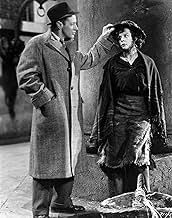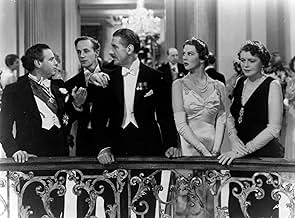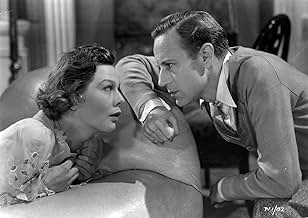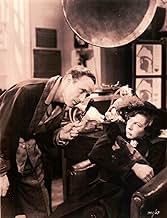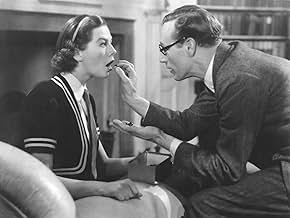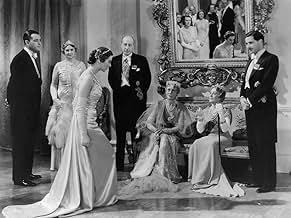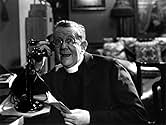Pygmalion
- 1938
- Tous publics
- 1h 36min
NOTE IMDb
7,7/10
10 k
MA NOTE
Un expert en phonétique et en diction fait le pari qu'il peut apprendre à une fille aux fleurs de cockney à parler un anglais correct et à se faire passer pour une dame de la haute société.Un expert en phonétique et en diction fait le pari qu'il peut apprendre à une fille aux fleurs de cockney à parler un anglais correct et à se faire passer pour une dame de la haute société.Un expert en phonétique et en diction fait le pari qu'il peut apprendre à une fille aux fleurs de cockney à parler un anglais correct et à se faire passer pour une dame de la haute société.
- Réalisation
- Scénario
- Casting principal
- Récompensé par 1 Oscar
- 4 victoires et 5 nominations au total
Leueen MacGrath
- Clara Eynsford Hill
- (as Leueen Macgrath)
Irene Browne
- Duchess
- (as Irene Brown)
Cathleen Nesbitt
- A Lady
- (as Kathleen Nesbitt)
Avis à la une
While My Fair Lady was a tremendous film which is a pleasure to watch and rewatch, Pygmalion is the true cinematic version of Shaw's work and this version is brilliant. While I still have mixed feelings about the Henry-Eliza relationship and the play ending, it has to be said that the two leads here are perfect for their roles. There were not many British actors better than Howard at the time for this type of thing, and Wendy Hiller never disappointed her audience once in her long career. A good film full of detail and feeling. The one sticking point is the weak and feeble Freddie who at least was given a personality in MFL. Here you can't wonder that Eliza is so quick to discard his attentions. A film which should be celebrated and treasured more in the UK than it is.
Nearly 70 years later the Gabriel Pascal "Pygmalion" still sets the bar for film adaptation of a stage play. So much so, in fact, that the GBS incorporated many of the film's upgrades into the authoritative published version of the play, despite the play being more than 20 years old when the film was made.
When was the last time you saw a performance leap off the screen like Leslie Howard's as Professor Higgins? Shaw never saw such treatment on screen again, even under Pascal's hand. The film of "Major Barbara" is interesting (and a bit bizarre toward the end) in its own right, with some magnificent bits in the Act II homeless shelter and a heart-wrenching Wendy Hiller, but pales next to the stage version in its intellectual, political and dramatic depth. And all the rest, even the charming "Caesar and Cleopatra" with Raines and Leigh, just don't cut it compared to the plays.
"Pygmalion" is where any screenwriter needs to start in adapting a play for the movies. No one has done it better since.
(BTW, GBS's afterward to "Pygmalion" is intended to be tongue-in-cheek, I think. It's intentionally ridiculous, so that the mob clamoring for a romantic ending would realize just how inappropriate and uninteresting that would have been.)
When was the last time you saw a performance leap off the screen like Leslie Howard's as Professor Higgins? Shaw never saw such treatment on screen again, even under Pascal's hand. The film of "Major Barbara" is interesting (and a bit bizarre toward the end) in its own right, with some magnificent bits in the Act II homeless shelter and a heart-wrenching Wendy Hiller, but pales next to the stage version in its intellectual, political and dramatic depth. And all the rest, even the charming "Caesar and Cleopatra" with Raines and Leigh, just don't cut it compared to the plays.
"Pygmalion" is where any screenwriter needs to start in adapting a play for the movies. No one has done it better since.
(BTW, GBS's afterward to "Pygmalion" is intended to be tongue-in-cheek, I think. It's intentionally ridiculous, so that the mob clamoring for a romantic ending would realize just how inappropriate and uninteresting that would have been.)
After seeing Leslie Howard as Henry Higgins, there is no way I could find Rex Harrison half as appealing, with his chanting/singing, in My Fair Lady. Leslie Howard simply is Henry Higgins, and if he seems unappealing and unlikable, that's because he's supposed to be unappealing and unlikable -- Henry Higgins is not a nice man. Howard does an incredible job with the role, and Wendy Hiller's Eliza puts Audrey Hepburn, as lovely as she is, to shame.
If George Bernard Shaw thought that Howard's interpretation of his play was good, then who are we to argue?
If George Bernard Shaw thought that Howard's interpretation of his play was good, then who are we to argue?
Even if I had not yet seen this film I'd have had good reason to assume its merit simply because George Bernard Shaw, as cantankerous and protective of his work as he was, liked it. But I have seen it, many times, and that only validates that conclusion.
Leslie Howard not only starred in it but co-directed as well, and accomplished both magnificently. His rapid-fire intensity, conveying the true overbearing Higgins using Eliza as if she were "a block of wood," to quote, to be sawed, hewn, nailed, drilled and pounded into an object to his liking, is wonderfully complemented by Wendy Hiller's Eliza, bringing us to understand the full range of her growth from the depths of her imprisonment in the class of the street vendor barely escaping mendacity by selling flowers to a real princess, not by royal birth, but by her strength and accomplishment. Higgins may like to claim credit for her transformation; but it's Eliza who really made it happen.
There's a lot said here comparing Pygmalion to My Fair Lady. That's really a classic apples-and-oranges fallacy. Musical theatre is an entirely different art form, with a different goal. It's clear that if this interpretation of Pygmalion had been duplicated with songs and dances tacked on, it would have been horrible; yet My Fair Lady is a triumph of its art. It's often called a musical adaptation. That's mistaken; it's "based on" Pygmalion. The nature of musical theatre requires a different approach. To evaluate either by the standards of the other is a waste of time and thought.
Shaw would undoubtedly have hated MFL; his revulsion for Romanticism and the failure of The Chocolate Soldier, the operetta based on Arms and the Man, would guarantee that. MFL is not a musical Pygmalion, and should never be mistaken for one.
It is a great tribute to the genius of George Bernard Shaw and his best-known play that it could spawn both this artful and powerful movie version and a greatly different and beautiful musical as well.
Leslie Howard not only starred in it but co-directed as well, and accomplished both magnificently. His rapid-fire intensity, conveying the true overbearing Higgins using Eliza as if she were "a block of wood," to quote, to be sawed, hewn, nailed, drilled and pounded into an object to his liking, is wonderfully complemented by Wendy Hiller's Eliza, bringing us to understand the full range of her growth from the depths of her imprisonment in the class of the street vendor barely escaping mendacity by selling flowers to a real princess, not by royal birth, but by her strength and accomplishment. Higgins may like to claim credit for her transformation; but it's Eliza who really made it happen.
There's a lot said here comparing Pygmalion to My Fair Lady. That's really a classic apples-and-oranges fallacy. Musical theatre is an entirely different art form, with a different goal. It's clear that if this interpretation of Pygmalion had been duplicated with songs and dances tacked on, it would have been horrible; yet My Fair Lady is a triumph of its art. It's often called a musical adaptation. That's mistaken; it's "based on" Pygmalion. The nature of musical theatre requires a different approach. To evaluate either by the standards of the other is a waste of time and thought.
Shaw would undoubtedly have hated MFL; his revulsion for Romanticism and the failure of The Chocolate Soldier, the operetta based on Arms and the Man, would guarantee that. MFL is not a musical Pygmalion, and should never be mistaken for one.
It is a great tribute to the genius of George Bernard Shaw and his best-known play that it could spawn both this artful and powerful movie version and a greatly different and beautiful musical as well.
Shaw's brilliant play is expertly filmed by Howard and Asquith. Howard is perfectly cast as the snobbish Professor Higgins and is matched by Hiller, in her second film, as Eliza Doolittle. The fine supporting cast includes Sunderland, Lawson, and Lohr, who's terrific as Mrs. Higgins. It is difficult to make a bad film of this work, given Shaw's witty dialog, but film performance is different from stage performance, with film calling for more subtlety. The love-hate relationship between the professor and Eliza works wonderfully because Howard and Hiller provide the right combination of humor and humanity. Howard's role here is in sharp contrast to the wimpy Ashley the following year in "Gone with the Wind."
Le saviez-vous
- AnecdotesThe scene in which Eliza accidentally swallows a marble while having an elocution lesson does not appear in the original play. During rehearsals for this scene, a pained expression came over Wendy Hiller's face. When she spat out the marbles she had in her mouth, she said, "Leslie, I've swallowed one!" to which Leslie Howard replied, "Never mind, there are plenty more." This caused such amusement among the watching crew that it was added to the movie and to its musical version, My Fair Lady (1964).
- GaffesAfter the ball when Mrs. Pearce serves Professor Higgins his tea, the shadow of the camera can be seen in the bottom left, moving back across his blanket.
- Citations
Eliza Doolittle: Walk? Not bloody likely. I'm going in a taxi.
- Crédits fousOpening credits prologue: PYGMALION WAS A MYTHOLOGICAL CHARACTER WHO DABBLED IN SCULPTURE. HE MADE A STATUE OF HIS IDEAL WOMAN-GALATEA. IT WAS SO BEAUTIFUL THAT HE PRAYED THE GODS TO GIVE IT LIFE. HIS WISH WAS GRANTED.
BERNARD SHAW IN HIS FAMOUS PLAY GIVES A MODERN INTERPRETATION OF THIS THEME.
- Versions alternativesThis film was made a year before the Hays Office gave Clark Gable permission to say "Frankly, my dear, I don't give a damn", so while in the British prints of this film Leslie Howard often utters the word, in the American prints the word "damn" is replaced by either "hang" or "confounded".
- ConnexionsFeatured in Metro-Goldwyn-Mayer's Big Parade of Hits for 1940 (1940)
Meilleurs choix
Connectez-vous pour évaluer et suivre la liste de favoris afin de recevoir des recommandations personnalisées
- How long is Pygmalion?Alimenté par Alexa
Détails
- Date de sortie
- Pays d’origine
- Langue
- Aussi connu sous le nom de
- Pigmalion
- Lieux de tournage
- Pinewood Studios, Iver Heath, Buckinghamshire, Angleterre, Royaume-Uni(studio: made at Pinewood Studios England)
- Société de production
- Voir plus de crédits d'entreprise sur IMDbPro
Box-office
- Budget
- 87 000 £GB (estimé)
- Durée1 heure 36 minutes
- Couleur
- Rapport de forme
- 1.37 : 1
Contribuer à cette page
Suggérer une modification ou ajouter du contenu manquant


